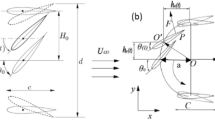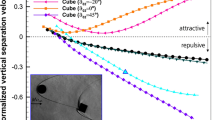Abstract
The flow field around a helicopter is characterised by its inherent complexity including effects of fluid–structure interference, shock–boundary layer interaction, and dynamic stall. Since the advancement of computational fluid dynamics and computing capabilities has led to an increasing demand for experimental validation data, a comprehensive wind tunnel test campaign of a fully equipped and motorised generic medium transport helicopter was conducted in the framework of the GOAHEAD project. Different model configurations (with or without main/tail rotor blades) and several flight conditions were investigated. In this paper, the results of the three-component velocity field measurements around the model are surveyed. The effect of the interaction between the main rotor wake and the fuselage for cruise/tail shake flight conditions was analysed based on the flow characteristics downstream from the rotor hub and the rear fuselage hatch. The results indicated a sensible increment of the intensity of the vortex shedding from the lower part of the fuselage and a strong interaction between the blade vortex filaments and the wakes shed by the rotor hub and by the engine exhaust areas. The pitch-up phenomenon was addressed, detecting the blade tip vortices impacting on the horizontal tail plane. For high-speed forward flight, the shock wave formation on the advancing blade was detected, measuring the location on the blade chord and the intensity. Furthermore, dynamic stall on the retreating main rotor blade in high-speed forward flight was observed at r/R = 0.5 and 0.6. The analysis of the substructures forming the dynamic stall vortex revealed an unexpected spatial concentration suggesting a rotational stabilisation of large-scale structures on the blade.
















Similar content being viewed by others
Abbreviations
- CFD:
-
Computational fluid mechanics
- DEHS:
-
Di-ethyl-hexyl-sebacat
- DS:
-
Dynamic stall
- GOAHEAD:
-
Generation of advanced helicopter experimental aerodynamic database for CFD code validation
- PIV:
-
Particle image velocimetry
- WT:
-
Wind tunnel
- a :
-
Speed of sound, m/s
- c :
-
Blade chord, m
- L :
-
Fuselage length, m
- L m :
-
Measurement volume length, m
- M :
-
Mach number
- r :
-
Radial coordinate, m
- r v :
-
Vortex radius, m
- r c :
-
Vortex core radius, m
- R :
-
Rotor radius, m
- t :
-
Time, s
- u, v, w :
-
Velocity components, m/s
- V :
-
Velocity, m/s
- V r, V θ :
-
Radial and tangential velocity, m/s
- x, y, z :
-
Coordinates, m
- α:
-
Fuselage incidence angle, deg
- ε:
-
Measurement error
- Γ:
-
Circulation, m2/s
- λ2 :
-
Flow field operators, (rad/s)2
- μ:
-
Advance ratio, V/(Ω R)
- ν:
-
Kinematic viscosity, m2/s
- ρ:
-
Air density, kg/m3
- σ:
-
Standard deviation
- Ψ:
-
Azimuth, Ω t, deg
- ω:
-
Vorticity, rad/s
- Ω:
-
Rotor rotational frequency, rad/s
- b :
-
Blade
- MR:
-
Main rotor
- TR:
-
Tail rotor
- WT:
-
Wind tunnel
- s :
-
Shaft
- u :
-
Velocity
- x :
-
Displacement
References
Althoff Gorton S, Berry JD, Hodge WT, Reis DG (2002) Rotor Wake Study Near the Horizontal Tail of a T-Tail Configuration. J Aircr 39(4):645–653
Barbagallo D, De Gregorio F, Tino N (2000) Pitch-up phenomenon characterisation by means of HW and PIV measurements techniques. In: Proceedings of the 26th European rotorcraft forum, The Hague, NL
Benoit B, Dequin AM, Kampa K, von Grünhagen W, Basset PM, Gimonet B (2000) HOST, a general helicopter simulation tool for Germany and France. In: Proceedings of the American helicopter society 56th annual forum, Virginia Beach, VA, USA
de Waard PG, Trouvé M (1999) Tail shake vibration. In: Proceedings of the 55th American helicopter society, Montreal, Canada
DiOttavio J, Watson K, Cormey J, Komerath N (2008) Discrete structures in the radial flow over a rotor blade in dynamic stall. In: Proceedings of the 26th applied aerodynamics conference, AIAA, Honolulu, Hawaii, USA
Fletcher TM, Brown RE (2007) Main rotor—empennage interaction and its effects on helicopter flight dynamics. In: Proceedings of the American helicopter society 63rd annual forum, Virginia Beach, VA, USA
Graftieaux L, Michard M, Grosjean N (2001) Combining PIV, POD and vortex identification algorithms for the study of unsteady turbulent swirling flows. Meas Sci Technol 12:1422–1429
Heineck JT, Yamauchi GK, Wadcock AJ, Lourenco LM, Abrego AI (2000) Application of three-component PIV to a hovering rotor wake. In: Proceedings of the AHS 56th annual forum, Virginia Beach, VA, USA
Kindler K, Mulleners K, Richard H, van der Wall BG, Raffel M (2011) Aperiodicity in the near field of full-scale rotor blade tip vortices. Exp Fluids 50:1601–1610
Le Pape A, Gatard J, Monnier JC (2007) Experimental investigations of rotor–fuselage aerodynamic interaction. J Am Helicopter Soc 52:99
Lee TE, Leishmann GJ, Ramasamy M (2008) Fluid dynamics of interacting blade tip vortices with a ground plane. In: Proceedings of the 64th annual forum of the American helicopter society, Montreal, Canada
Leishman JG (2000) Principle of helicopter aerodynamics. Cambridge University Press, Cambridge
Leishman JG, Bi NP (1994) Experimental investigation of rotor/lifting surface interactions. J Aircr 31(4):846–854. doi:10.2514/3.46570
Martin PB, Pugliese GJ, Leishman JG, Anderson SL (2000) Stereo PIV measurement in the wake of a hovering rotor. In: Proceedings of the AHS 56th annual forum, Virginia Beach, VA, USA
Martin PB, Pugliese GJ, Leishman JG (2001) High resolution trailing vortex measurements in the wake of a hovering rotor. In: Proceedings of the AHS 57th annual forum, Washington, DC, USA
McCroskey W (1981) The phenomenon of dynamic stall. TM 81264, NASA
Mulleners K, Kindler K, Raffel M (2011) Dynamic stall on a fully equipped helicopter model. Aerosp Sci Technol (in press). doi:10.1016/j.ast.2011.03.013
Pahlke KG (2007) The GOAHEAD project. In: Proceedings of the 33rd European rotorcraft forum, Kazan, Russia
Raffel M, Seelhorst U, Willert C (1998) Vortical flow structures at a helicopter rotor model measured by LDV and PIV. Aeronaut J R Aeronaut Soc 102(1012):221–227
Raffel M, Richard H, Ehrenfried K, Van der Wall B, Burley C, Beaumier P, McAlister K, Pengel K (2004) Recording and evaluation methods of PIV investigations on a helicopter rotor model. Exp Fluids 36:146–156
Raffel M, De Gregorio F, Sheng W, Gibertini G, Seraudie A, de Groot K, van der Wall BG (2009) Generation of an advanced helicopter experimental aerodynamic database. In: Proceedings of the 35th European rotorcraft forum, Hamburg, Germany
Raffel M, De Gregorio F, de Groot K, Schneider O, Sheng W, Gibertini G, Seraudie A (2011) On the generation of a helicopter aerodynamic database. Aeronaut J 115(1164):103–112
Raghav V, Richards P, Komerath N, Smith M (2010) An exploration of the physics of dynamic stall. In: Proceedings of AHS aeromechanics specialists conference, AHS, San Francisco, CA, USA
Spentzos A, Barakos GN, Badcock KJ, Richards BE (2006) Modelling three-dimensional dynamic stall of helicopter blades using computational fluid dynamics and neural networks, Proceedings of the Institute of Mechanical Engineers, Part G. J Aeros Eng 220(6):605–618
Van der Wall BG, Richard H (2006) Analysis methodology for 3C-PIV data of rotary wing vortices. Exp Fluids 40:798–812
Vollmers H (2001) Detection of vortices and quantitative evaluation of their main parameters from experimental velocity data. Meas Sci Technol 12:1199–1207
Acknowledgments
This project was funded by the European Union within the 6th Framework European Research Programme, contract Nr. 516074. The professional and personal commitment to the project by all the GOAHEAD partners and the DNW staff is gratefully acknowledged.
Author information
Authors and Affiliations
Corresponding author
Rights and permissions
About this article
Cite this article
De Gregorio, F., Pengel, K. & Kindler, K. A comprehensive PIV measurement campaign on a fully equipped helicopter model. Exp Fluids 53, 37–49 (2012). https://doi.org/10.1007/s00348-011-1185-0
Received:
Revised:
Accepted:
Published:
Issue Date:
DOI: https://doi.org/10.1007/s00348-011-1185-0




